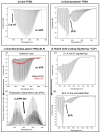Optical Fiber Gratings Immunoassays
- PMID: 31181610
- PMCID: PMC6603621
- DOI: 10.3390/s19112595
Optical Fiber Gratings Immunoassays
Abstract
Optical fibers are of growing interest for biosensing, especially for point-of-care and biomedical assays. Their intrinsic properties bestow them sought-after assets for the detection of low concentrations of analytes. Tilted fiber Bragg gratings (TFBGs) photo-inscribed in the core of telecommunication-grade optical fibers are known to be highly-sensitive refractometers. In this work, we present different strategies to use them for label-free immunoassays. Bare, gold-sputtered, gold-electroless-plated (ELP) and hybrid configurations are biofunctionalized with antibodies, aiming at the detection of cancer biomarkers. We discuss the relative performances of the tested configurations and show that each leads to singular key features, which therefore drives their selection as a function of the target application. The most sensitive configuration presents a limit of detection of 10-12 g/mL in laboratory settings and was successfully used ex vivo in freshly resected lung tissues.
Keywords: biomarker; biosensing; immunoassays; optical fibers; tilted fiber bragg gratings.
Conflict of interest statement
The authors declare no conflict of interest
Figures








References
-
- Yin M., Gu B., An Q., Yang C., Guan Y.L., Yong K. Recent development of fiber-optic chemical sensors and biosensors: Mechanisms, materials, micro/nano-fabrications and applications. Coord. Chem. Rev. 2018;376:348–392. doi: 10.1016/j.ccr.2018.08.001. - DOI
-
- Gupta B.D., Kant R. Recent advances in surface plasmon resonance based fiber optic chemical and biosensors utilizing bulk and nanostructures. Opt. Laser Technol. 2018;101:144–161. doi: 10.1016/j.optlastec.2017.11.015. - DOI
MeSH terms
Substances
LinkOut - more resources
Full Text Sources

